Galeria de retlaw snellac
india - ladakh - zanskar - kasjmir - himachal pradesh
A trip starting in Srinagar and ending in Delhi with a lot of highlights in the Zanskar valley and in Ladakh.
See also:
www.flickriver.com/photos/waltercallens/ random/
www.flickr.com/photos/waltercallens/favo rites/
english.cohga.net/flickr/user/74089637@N 00_1.html
www.fluidr.com/photos/waltercallens/sets
www.lurvely.com/index.php?owner=74089637 @N00
Created with Admarket's flickrSLiDR.

india - ladakh
Treasure of the monastery of Lamayuru.
Lamayuru Monastery is situated in Ladakh, in between Bodhkharbu and Kha-la-che, on a steep rock mountain. It lies at a distance of approximately 127 km to the west of Leh town. Lamayuru Monastery belongs to the Red-Hat sect of Buddhism and houses approximately 150 Buddhist monks. The monastery is made up of a number of shrines and also has a very rich collection of thankas and magnificent wall paintings. At the outset, the Lamayuru Monastery consisted of five buildings, out of which only the central one exists today.
Every year the Lamayuru Gompa plays host a masked dance, which takes place on the 17th and 18th day of the 5th month of Tibetan lunar calendar. The monks from the monasteries of the nearby areas also come to take part in the celebrations. There is an interesting legend associated with the Lamayuru Gompa of Leh Ladakh. It is said that the Lamayuru Valley used to be a clear lake, at the time of Sakyamuni (the Historical Buddha). And, nagas (holy serpents) used to reside in the lake.
Bodhisattva Madhyantaka had once a prediction quite a long time back that the lake would eventually be dried, making way for the construction of a Buddhist monastery. The legend moves further to state that Mahasiddhacharya Naropa, an 11th century Indian Buddhist scholar, sat in meditation for a number of years in one of the caves in Dukhang. He was the one who caused a crack in the hillside surrounding the lake.
Through this crack, the lake started draining. When the lake dried out, the scholar found a dead lion lying inside it. On the same spot, where he found the tiger, he constructed the first temple of the area, known as the Singhe Ghang (Lion Mound). Another legend has it that the building of Lamayuru Monastery was constructed, as per the instructions of King of Ladakh, under the direction of Rinchen Zangpo, the Translator. After this, the monastery came under the administration of the Zhwa-mar-pa (Red Hats).

india - ladakh
Treasure of the monastery of Lamayuru.
Lamayuru Monastery is situated in Ladakh, in between Bodhkharbu and Kha-la-che, on a steep rock mountain. It lies at a distance of approximately 127 km to the west of Leh town. Lamayuru Monastery belongs to the Red-Hat sect of Buddhism and houses approximately 150 Buddhist monks. The monastery is made up of a number of shrines and also has a very rich collection of thankas and magnificent wall paintings. At the outset, the Lamayuru Monastery consisted of five buildings, out of which only the central one exists today.
Every year the Lamayuru Gompa plays host a masked dance, which takes place on the 17th and 18th day of the 5th month of Tibetan lunar calendar. The monks from the monasteries of the nearby areas also come to take part in the celebrations. There is an interesting legend associated with the Lamayuru Gompa of Leh Ladakh. It is said that the Lamayuru Valley used to be a clear lake, at the time of Sakyamuni (the Historical Buddha). And, nagas (holy serpents) used to reside in the lake.
Bodhisattva Madhyantaka had once a prediction quite a long time back that the lake would eventually be dried, making way for the construction of a Buddhist monastery. The legend moves further to state that Mahasiddhacharya Naropa, an 11th century Indian Buddhist scholar, sat in meditation for a number of years in one of the caves in Dukhang. He was the one who caused a crack in the hillside surrounding the lake.
Through this crack, the lake started draining. When the lake dried out, the scholar found a dead lion lying inside it. On the same spot, where he found the tiger, he constructed the first temple of the area, known as the Singhe Ghang (Lion Mound). Another legend has it that the building of Lamayuru Monastery was constructed, as per the instructions of King of Ladakh, under the direction of Rinchen Zangpo, the Translator. After this, the monastery came under the administration of the Zhwa-mar-pa (Red Hats).
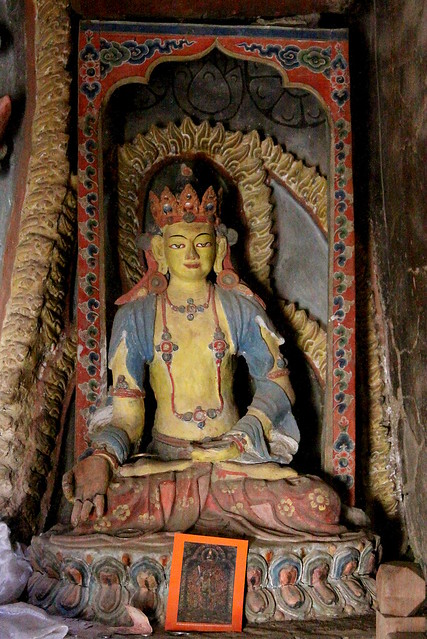
india - ladakh
Treasure of the monastery of Lamayuru.
Lamayuru Monastery is situated in Ladakh, in between Bodhkharbu and Kha-la-che, on a steep rock mountain. It lies at a distance of approximately 127 km to the west of Leh town. Lamayuru Monastery belongs to the Red-Hat sect of Buddhism and houses approximately 150 Buddhist monks. The monastery is made up of a number of shrines and also has a very rich collection of thankas and magnificent wall paintings. At the outset, the Lamayuru Monastery consisted of five buildings, out of which only the central one exists today.
Every year the Lamayuru Gompa plays host a masked dance, which takes place on the 17th and 18th day of the 5th month of Tibetan lunar calendar. The monks from the monasteries of the nearby areas also come to take part in the celebrations. There is an interesting legend associated with the Lamayuru Gompa of Leh Ladakh. It is said that the Lamayuru Valley used to be a clear lake, at the time of Sakyamuni (the Historical Buddha). And, nagas (holy serpents) used to reside in the lake.
Bodhisattva Madhyantaka had once a prediction quite a long time back that the lake would eventually be dried, making way for the construction of a Buddhist monastery. The legend moves further to state that Mahasiddhacharya Naropa, an 11th century Indian Buddhist scholar, sat in meditation for a number of years in one of the caves in Dukhang. He was the one who caused a crack in the hillside surrounding the lake.
Through this crack, the lake started draining. When the lake dried out, the scholar found a dead lion lying inside it. On the same spot, where he found the tiger, he constructed the first temple of the area, known as the Singhe Ghang (Lion Mound). Another legend has it that the building of Lamayuru Monastery was constructed, as per the instructions of King of Ladakh, under the direction of Rinchen Zangpo, the Translator. After this, the monastery came under the administration of the Zhwa-mar-pa (Red Hats).

india - ladakh
Treasure of the monastery of Lamayuru.
Lamayuru Monastery is situated in Ladakh, in between Bodhkharbu and Kha-la-che, on a steep rock mountain. It lies at a distance of approximately 127 km to the west of Leh town. Lamayuru Monastery belongs to the Red-Hat sect of Buddhism and houses approximately 150 Buddhist monks. The monastery is made up of a number of shrines and also has a very rich collection of thankas and magnificent wall paintings. At the outset, the Lamayuru Monastery consisted of five buildings, out of which only the central one exists today.
Every year the Lamayuru Gompa plays host a masked dance, which takes place on the 17th and 18th day of the 5th month of Tibetan lunar calendar. The monks from the monasteries of the nearby areas also come to take part in the celebrations. There is an interesting legend associated with the Lamayuru Gompa of Leh Ladakh. It is said that the Lamayuru Valley used to be a clear lake, at the time of Sakyamuni (the Historical Buddha). And, nagas (holy serpents) used to reside in the lake.
Bodhisattva Madhyantaka had once a prediction quite a long time back that the lake would eventually be dried, making way for the construction of a Buddhist monastery. The legend moves further to state that Mahasiddhacharya Naropa, an 11th century Indian Buddhist scholar, sat in meditation for a number of years in one of the caves in Dukhang. He was the one who caused a crack in the hillside surrounding the lake.
Through this crack, the lake started draining. When the lake dried out, the scholar found a dead lion lying inside it. On the same spot, where he found the tiger, he constructed the first temple of the area, known as the Singhe Ghang (Lion Mound). Another legend has it that the building of Lamayuru Monastery was constructed, as per the instructions of King of Ladakh, under the direction of Rinchen Zangpo, the Translator. After this, the monastery came under the administration of the Zhwa-mar-pa (Red Hats).
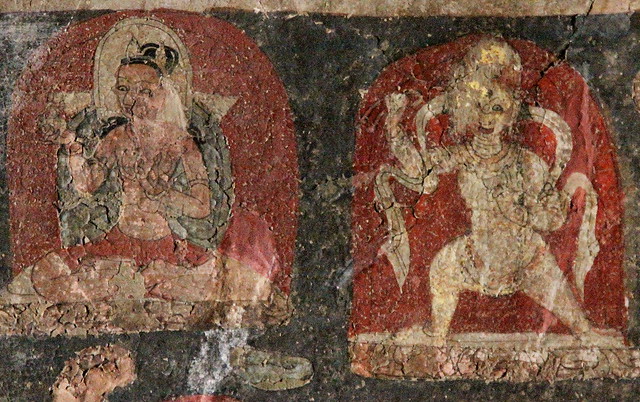
india - ladakh
Treasure of the monastery of Lamayuru.
Lamayuru Monastery is situated in Ladakh, in between Bodhkharbu and Kha-la-che, on a steep rock mountain. It lies at a distance of approximately 127 km to the west of Leh town. Lamayuru Monastery belongs to the Red-Hat sect of Buddhism and houses approximately 150 Buddhist monks. The monastery is made up of a number of shrines and also has a very rich collection of thankas and magnificent wall paintings. At the outset, the Lamayuru Monastery consisted of five buildings, out of which only the central one exists today.
Every year the Lamayuru Gompa plays host a masked dance, which takes place on the 17th and 18th day of the 5th month of Tibetan lunar calendar. The monks from the monasteries of the nearby areas also come to take part in the celebrations. There is an interesting legend associated with the Lamayuru Gompa of Leh Ladakh. It is said that the Lamayuru Valley used to be a clear lake, at the time of Sakyamuni (the Historical Buddha). And, nagas (holy serpents) used to reside in the lake.
Bodhisattva Madhyantaka had once a prediction quite a long time back that the lake would eventually be dried, making way for the construction of a Buddhist monastery. The legend moves further to state that Mahasiddhacharya Naropa, an 11th century Indian Buddhist scholar, sat in meditation for a number of years in one of the caves in Dukhang. He was the one who caused a crack in the hillside surrounding the lake.
Through this crack, the lake started draining. When the lake dried out, the scholar found a dead lion lying inside it. On the same spot, where he found the tiger, he constructed the first temple of the area, known as the Singhe Ghang (Lion Mound). Another legend has it that the building of Lamayuru Monastery was constructed, as per the instructions of King of Ladakh, under the direction of Rinchen Zangpo, the Translator. After this, the monastery came under the administration of the Zhwa-mar-pa (Red Hats).
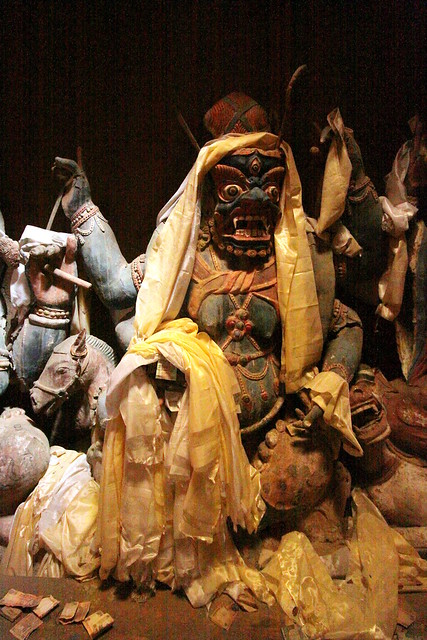
india - ladakh
Treasure of the monastery of Lamayuru.
Lamayuru Monastery is situated in Ladakh, in between Bodhkharbu and Kha-la-che, on a steep rock mountain. It lies at a distance of approximately 127 km to the west of Leh town. Lamayuru Monastery belongs to the Red-Hat sect of Buddhism and houses approximately 150 Buddhist monks. The monastery is made up of a number of shrines and also has a very rich collection of thankas and magnificent wall paintings. At the outset, the Lamayuru Monastery consisted of five buildings, out of which only the central one exists today.
Every year the Lamayuru Gompa plays host a masked dance, which takes place on the 17th and 18th day of the 5th month of Tibetan lunar calendar. The monks from the monasteries of the nearby areas also come to take part in the celebrations. There is an interesting legend associated with the Lamayuru Gompa of Leh Ladakh. It is said that the Lamayuru Valley used to be a clear lake, at the time of Sakyamuni (the Historical Buddha). And, nagas (holy serpents) used to reside in the lake.
Bodhisattva Madhyantaka had once a prediction quite a long time back that the lake would eventually be dried, making way for the construction of a Buddhist monastery. The legend moves further to state that Mahasiddhacharya Naropa, an 11th century Indian Buddhist scholar, sat in meditation for a number of years in one of the caves in Dukhang. He was the one who caused a crack in the hillside surrounding the lake.
Through this crack, the lake started draining. When the lake dried out, the scholar found a dead lion lying inside it. On the same spot, where he found the tiger, he constructed the first temple of the area, known as the Singhe Ghang (Lion Mound). Another legend has it that the building of Lamayuru Monastery was constructed, as per the instructions of King of Ladakh, under the direction of Rinchen Zangpo, the Translator. After this, the monastery came under the administration of the Zhwa-mar-pa (Red Hats).
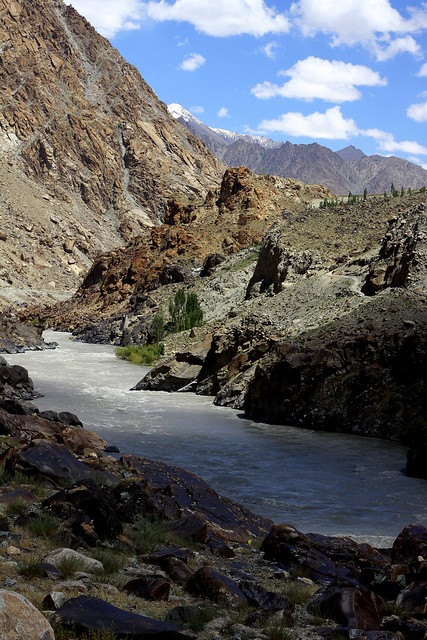
india - ladakh
The Indus river in the Dha valley (Ladakh).
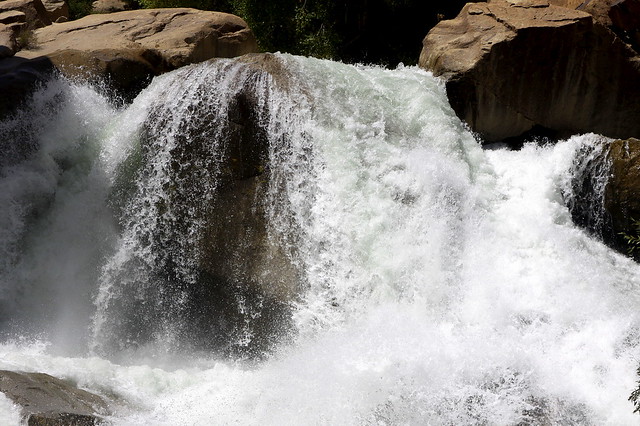
india - ladakh
Waterfall (Dha valley, Ladakh).
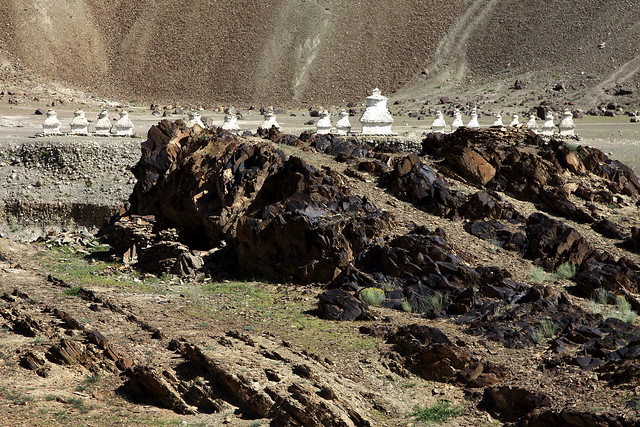
india - ladakh
Chortens at the entrance of the Dha valley (Ladakh).
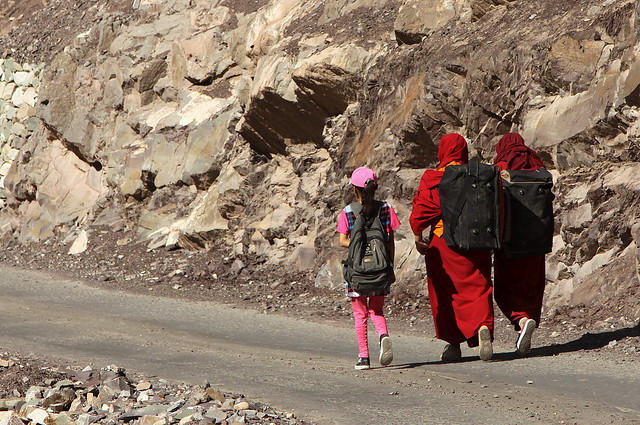
india - ladakh
On the way to school.
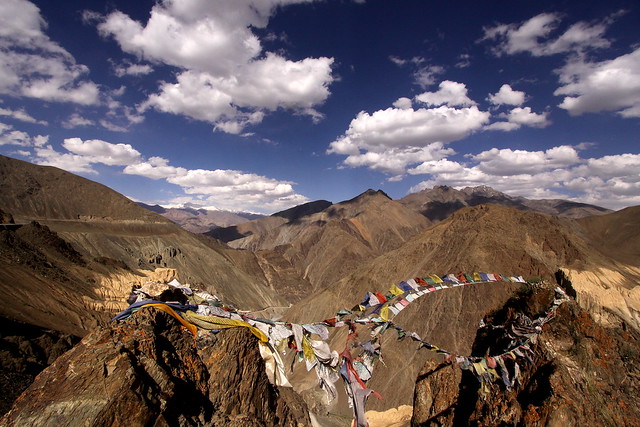
india - ladakh
Landscape on the way from Lamayuru to Khaltse (Ladakh).
| |||
| Accueil |Pensées Du Jour | | Galleries | La Bhagavad-gita Telle Qu'elle Est |
| | Le Cours Ultime de la Réalisation du Soi (tm) | | |
| Obtenez la miséricorde spéciale de Krishna en faisant du service de dévotion Aidez Sankarshan Prabhu dans sa mission de répandre la conscience de Krishna partout dans le monde. Une contribution singulière ou mensuelle peut se faire en ligne en allant ici : | Un appel pour votre assistance Sur l’ordre de son maître spirituel, Srila Prabhupada, Sankarshan Prabhu à dédié sa vie au travail extrêmement urgent de répandre la conscience de Krishna partout dans le monde. Le plus la conscience de Krishna se répand, le plus que la souffrance, le manque et la haine sur cette planète seront remplacés par la félicité, l’abondance et l’amour. Voici une opportunité dorée de faire le plus grand bien pour toutes les entités vivantes et de recevoir les bénédictions spéciales du Seigneur. Par conséquent, nous devons, au mesure du possible, sacrifier notre temps, notre énergie et nos ressources pour aider Sankarshan Prabhu dans son travail urgent. Si vous voulez participer d’une façon ou d’une autre, grande ou petite, veuillez écrire à Sankarshan Prabhu en cliquant si dessous : Envoyer un courriel à Sankarshan Prabhu
| de Sankarshan Prabhu |
| |
| Accueil |Pensées Du Jour | Conférences (en Anglais) | Autres Services| Galleries | Méditations sur la Bhakti Pure | |
|

Up

TABLA - FUENTES - FONTS
SOUV2
- SOUV2P.TTF - 57 KB
- SOUV2I.TTF - 59 KB
- SOUV2B.TTF - 56 KB
- SOUV2T.TTF - 56 KB
- bai_____.ttf - 46 KB
- babi____.ttf - 47 KB
- bab_____.ttf - 45 KB
- balaram_.ttf - 45 KB
- SCAGRG__.TTF - 73 KB
- SCAGI__.TTF - 71 KB
- SCAGB__.TTF - 68 KB
- inbenr11.ttf - 64 KB
- inbeno11.ttf - 12 KB
- inbeni11.ttf - 12 KB
- inbenb11.ttf - 66 KB
- indevr20.ttf - 53 KB
- Greek font: BibliaLS Normal
- Greek font: BibliaLS Bold
- Greek font: BibliaLS Bold Italic
- Greek font: BibliaLS Italic
- Hebrew font: Ezra SIL
- Hebrew font: Ezra SIL SR
Disculpen las Molestias

Up
Sankarshan Das Adhikari - ANUAL
Conceptos Hinduistas (1428)SC
Aa-Anc · Aga - Ahy · Ai - Akshay · Akshe - Amshum · Ana - Ancie · Ang - Asvayu · Ata - Az · Baa-Baz · Be-Bhak · Bhal-Bu · C · Daa-Daz · De · Dha-Dry · Du-Dy · E · F · Gaa-Gayu · Ge-Gy · Ha-He · Hi-Hy · I · J · K · Ka - Kam · Kan - Khatu · Ki - Ko · Kr - Ku · L · M · N · O · P · R · S · Saa-San · Sap-Shy · Si-Sy · Ta - Te · U · V · Ve-Vy · Y · Z
Conceptos Hinduistas (2919) SK
Aa-Ag · Ah-Am · Ana-Anc · And-Anu · Ap-Ar · As-Ax · Ay-Az · Baa-Baq · Bar-Baz · Be-Bhak · Bhal-Bhy · Bo-Bu · Bra · Brh-Bry · Bu-Bz · Caa-Caq · Car-Cay · Ce-Cha · Che-Chi · Cho-Chu · Ci-Cn · Co-Cy · Daa-Dan · Dar-Day · De · Dha- Dny · Do-Dy · Ea-Eo · Ep-Ez · Faa-Fy · Gaa-Gaq · Gar-Gaz · Ge-Gn · Go · Gra-Gy · Haa-Haq · Har-Haz · He-Hindk · Hindu-Histo · Ho-Hy · Ia-Iq · Ir- Is · It-Iy · Jaa- Jaq · Jar-Jay · Je-Jn · Jo-Jy · Kaa-Kaq · Kar-Kaz · Ke-Kh · Ko · Kr · Ku - Kz · Laa-Laq · Lar-Lay · Le-Ln · Lo-Ly · Maa-Mag · Mah · Mai-Maj · Mak-Maq · Mar-Maz · Mb-Mn · Mo-Mz · Naa-Naq · Nar-Naz · Nb-Nn · No-Nz · Oa-Oz · Paa-Paq · Par-Paz · Pe-Ph · Po-Py · Raa-Raq · Rar-Raz · Re-Rn · Ro-Ry · Saa-Sam · San-Sar · Sas-Sg · Sha-Shy · Sia-Sil · Sim-Sn · So - Sq · Sr - St · Su-Sz · Taa-Taq · Tar-Tay · Te-Tn · To-Ty · Ua-Uq · Ur-Us · Vaa-Vaq · Var-Vaz · Ve · Vi-Vn · Vo-Vy · Waa-Wi · Wo-Wy · Yaa-Yav · Ye-Yiy · Yo-Yu · Zaa-Zy










No hay comentarios:
Publicar un comentario